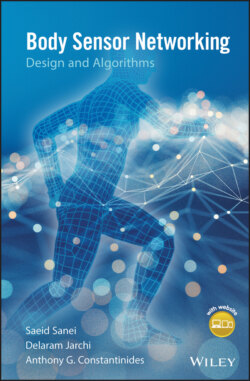Читать книгу Body Sensor Networking, Design and Algorithms - Saeid Sanei - Страница 37
3.4.1 The Structures of Biological Sensors – The Principles
ОглавлениеA biosensor consists of a biological sensing element and a transducer. The sensing elements can be organisms, tissues, cells, organelles, membranes, enzymes, receptors, antibodies, or nucleic acids. On the other hand, transducer types can be electrochemical, optical, calorimetric (thermal), or acoustic.
Bio-affinity transducers rely on very strong binding through which the transducer detects the bound receptor-analyte pair. The most common bio-affinity recognition processes are receptor-ligand binding and antibody-antigen binding.
Metabolic biosensors, on the other hand, sense the instances where the analytes are bound or the co-reactants are chemically altered, which in turn product molecules are formed, and the transducer detects the changes in concentration of the product molecules or co-reactants and consequently heat is released by the reaction. The common biometabolic processes are enzyme-substrate reactions and metabolism of specific molecules by organelles, tissues, and cells.
Biological recognition elements are immobilised on the surface of a transducer or in a membrane. This requires a bioreactor on top of a traditional transducer. The response of a biosensor is determined by four different factors: diffusion of the analyte, reaction products, co-reactants or interfering chemical species, and kinetics of the recognition process.
Various kinds of biosensors are mainly based on:
chemically sensitive semiconductor devices;
thermistors;
chemically mediated electrodes;
surface acoustic waves devices;
piezoelectric microbalances;
and many other individual or hybrid systems such as MEMS. As an example, for a quartz crystal microbalance sensor depicted in Figure 3.10 [44]:
an electrical AC voltage causes the resonator (i.e. the piezo layer) to oscillate;
a target molecule binds with a receptor based on the lock-and-key principle;
resonance frequency changes because of the weight change;
frequency change is translated into an electrical signal and processed further.
Some examples of the transducers used in the design of biosensors are micro-electrodes, combined ion-selective field-effect transistors and micro-electrodes, fibre optodes and luminescence, thermistors and thermocouples, and surface acoustic wave (SAW) delay lines (often used as piezoelectric elements in sensors and modelled using transversal filters) and bulk acoustic wave microbalances.
Figure 3.10 A quartz crystal microbalance sensor; a thin film sample is coated on the top gold electrode of the quartz shear mode resonator (QCM). The QCM is then inserted between the thermopile and the sample chamber. The experiment consists of varying the composition of the gas mixture at constant temperature and observing changes in the resonant frequency and motional resistance of the QCM and the thermal power flowing between the QCM and the aluminium heat sink via the thermopile.
Figure 3.11 (a) An EnzymFET and (b) its electrical output versus urea concentration [50].
Source: Courtesy of Middelhoek, S., and Audet, S.A.: Silicon Sensors, Academic Press Limited.
As an example, a schematic of a semiconductor sensor is illustrated in Figure 3.11. The back side is connected to a urea sensitive ISFET, often called an ENFET (EnzymFET), similar to that shown in Figure 3.11a. In Figure 3.11b the electrical voltage with respect to urea concentration is shown.
These sensors are carefully packaged using biocompatible materials. One of these types is shown in Figure 3.12. The backside is also shown in Figure 3.13.
Since 1962, when the early glucose oxidase electrode-based biosensor was manufactured by Clark and Lyons [45], many other sensors with various technologies and applications have been developed. Vigneshvar et al. [46] present a comprehensive study of biological sensors. Table 3.1 shows a large set of biosensors with their applications including the involved technology. Table 3.2 lists the uses of different biosensors for the diagnosis of various diseases [46].
Figure 3.12 A semiconductor biosensor schematic [51].
Source: Courtesy of John Wiley & Sons.
Figure 3.13 A semiconductor biosensor schematic; backside contacts [51].
Source: Courtesy of John Wiley & Sons.
